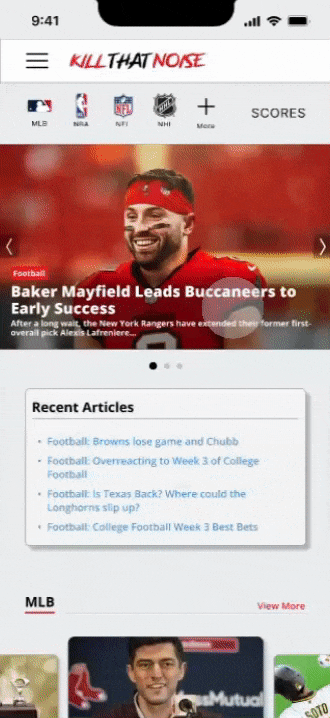Understanding the
Platform
When I joined Kill That Noise, one of the first challenges was addressing the website’s structural and usability issues. Core functions like user login and the ‘Contact Us’ page were either broken or difficult to find, which significantly impacted user trust.
The site’s navigation was cluttered with too many tabs, inconsistent naming, and redundant or empty sections—making it hard for users to locate content. The Information Architecture needed a complete overhaul to create a cleaner, more intuitive experience.
Visually, the site lacked cohesion. Inconsistent styles, poor use of white space, and no clear design system weakened the brand’s credibility.
Together with SEO and development, I helped rebuild the content structure, fix core functionality, and lay the foundation for a modern, accessible, and editorially aligned redesign.
Design Contributions
This phase focused on creating clarity, consistency, and a bold visual identity across web, mobile, and social media.
Visual Design & Branding
I introduced a cohesive color palette and typography system that reflected the platform’s bold, energetic tone. We refined logo usage, defined brand elements, and created reusable components to ensure consistency sitewide.
 Branding Style Guide
Branding Style Guide
UI Improvements
I redesigned key desktop and mobile pages to improve usability and responsiveness. The new layout made better use of white space, clarified content hierarchy, and added accessibility enhancements like better contrast and tap targets.
 Website Prototype (Desktop)
Website Prototype (Desktop)
 Sports Logo Library
Sports Logo Library
 Website Prototype (Mobile)
Website Prototype (Mobile)
Asset Creation
To support editorial and marketing teams, I designed visual assets for daily use:
- Social Media Templates — Reusable designs for promoting news, interviews, and game updates, helping unify the platform’s presence on Instagram and X (Twitter).
- Branded Email Newsletters — Mobile-friendly layouts aligned with the new visual identity, making campaigns easier to build and more engaging.


Marketing &
Social Media
Beyond design, I helped manage and streamline KTN’s social content strategy. Using the templates I built, I scheduled and published posts on Later, aligned with editorial releases.
This process ensured the team could focus on creating quality content, while I maintained a cohesive and recognizable brand presence across platforms.
Wrapping Up
From redesigning the site structure to supporting day-to-day marketing, this project brought together UX strategy, visual design, and team collaboration. It was a fast-paced, hands-on experience that pushed my skills and made a visible impact on the brand.
